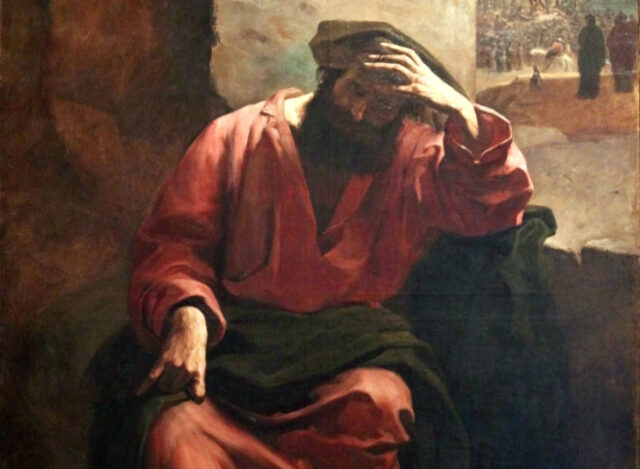Cy Kellett 0:21
Back to the phones.
We will go for Jimmy Chuck is in Cincinnati, Ohio watching on YouTube.
Chuck, welcome.
Go ahead with your question for Jimmy.
Chuck 0:31
Yeah, thanks a lot.
Hello, Mr. Akin.
We got to talk a number of times before anyway, so and this happened whenever there’s I don’t like using the word debate.
Maybe it’s a debate.
But just recently on the conflict.
Trent, you had a call a discussion with, quote unquote, Protestants, you and Mr. Trent.
And what happens usually when I hear . . .
Jimmy Akin 0:52
There’s no need for quotes, they were Protestant.
Chuck 0:57
Oh, yeah, quote, unquote.
I mean, that’s I mean, some people disagree with that word.
Oh, you guys are Protestants, which means you guys don’t exist.
Oh, thank you, Mr. Whoever, you know, so.
So that’s why I’m like, quote, unquote, anyway.
So whenever I listen to these, I’ll go ahead and call it a debate.
That is it’s like, initially, whoever’s talking, and it would be a Roman Catholic apologist.
Or maybe you are Mr. Trent.
And it’s like, the first half hour.
Us guys kind of sound like Martin Luther.
But then something else is added in.
So it’s like, Wait a minute.
And I and then I, of course, what happens, I end up calling Catholic Answers.
The same question again and again.
So I’m trying to trying to condense because there’s a lot of callers coming in, right.
So I’m going to try to condense this.
Jimmy Akin 1:45
Thank you.
Chuck 1:48
Thank you, sir.
So justification, is it faith in Christ, which results in imputation of His righteousness, which justifies full stop? Or is it actually faith in Christ, which results in imputation of the righteousness of Christ, but also your cooperation? In that you maintain it such that, to have peace with God and maintain it to get into heaven? It’s, it’s Christ’s work, but also your cooperation, Lord, I You should let me in because of Christ, but also because I stayed in it by cooperating.
Jimmy Akin 2:30
Okay, so I should provide a little bit of context for folks who may not know what you’re referring to.
Last week, Trent and I had a tag team debate on a program on YouTube called the gospel truth, which is hosted by a gentleman named Marlon Wilson.
And we were debating it was it was considered a debate.
It was we were debating two gentlemen, one of whom was a Reformed Baptist, and one of whom was a an Anglican.
And the debate was split into two halves.
The first half was sort of the biblical and theological dimensions of justification.
And I handled that.
And then the second part of the debate was on what the early church fathers believed about justification.
And Trent handled that.
So that’s the context in which this occurred.
And I do what I always do when I talk about justification, or when I approach basically any issue, I look for common ground to see what we don’t need to fight over.
And then whatever remains is something we can discuss.
But you know, you don’t start by trying to maximize differences between you and your opponent, you want to recognize where you have where you agree on things and clarify that so that, you know, we don’t waste our time arguing about something we actually agree on.
So to address your questions, we have to distinguish between what you do to get into a state of justification, and then what happens afterwards.
And that was a distinction that you brought up, when it comes to how you get into a state of justification.
Now, the ordinary way that this happens, is a person repents, believes and is baptized, but there are, you know, situations God knows you can’t always be baptized.
And so he makes provision for people who aren’t who don’t know that they need to be baptized or things or don’t have the opportunity to be baptized.
Fundamentally, the one thing that you need to be in a state of justification is faith in God through Christ.
And that faith needs to incorporate it not just any kind of faith saves.
Scripture makes that clear.
You know, James, James, chapter two, for example, refers to intellectual faith.
James says, even the demons believe, but they shudder at the prospect of God’s wrath.
So intellectual faith does not save you, St.
Paul, and First Corinthians 13 discusses what sometimes called fiducial.
Faith.
fiducial means trust him.
So this is Faith where you not only believe but you also trust.
And when St.
Paul says if I have faith such as to remove mountains, and if God’s moving mountains for you, you’re really trusting him.
But St.
Paul says, If I have faith strong enough to remove mountains, but I have not love, I’m nothing, it benefits me nothing.
So you don’t.
So merely fiducial faith is not enough.
But he says in Galatians, five, what counts in Christ is not circumcision or uncircumcision.
But faith working through love.
So that’s what you really need, in order to be justified, that’s the one if you have nothing else, the one thing that make sure you’re in a state of justification is faith that incorporates intellectual belief, trust in God, and love for God.
And if you have that kind of faith, it’s referred to as fit formed faith or faith formed by love or faith formed by charity.
And if you’ve got that you are in a state of justification.
And that’s something that a lot of folks agree with.
And the Protestant community, for example, John Calvin was one of those people.
He he, he said that if you try to take love out of faith, it’s not even worth calling it faith anymore.
So he agreed that formed faith is what saves.
And so that’s what you do to get into a state of justification.
Now, you then ask, Well, what happens after that? Do you have to do something to stay in a state of justification that you would appeal to, to God? Well, virtually all Christians, historically, except for those in the reformed tradition, have recognized that it is possible for Christians to commit certain sins that would cost them their salvation, because remember, one of the one of the requirements for justifying faith and is to repent and love God, well, if I decided to just go out and murder people of my own free will, you know, not under some psychological compulsion, but just, hey, I think I want to murder some people today.
Well, that’s inconsistent with love of neighbor, and it’s inconsistent with love of God.
So I no longer have saving faith, because the love component is gone.
And people in the Protestant community would agree with that.
They sometimes define exactly what kinds of sins would would cost you your salvation a little differently.
But the fact that it is possible to lose your salvation is agreed to by Lutherans and Anglicans and Methodists and Pentecostals and free will Baptists and general Baptists.
It’s really only people in the reformed tradition that object to this.
So all you really got to do in order to remain in a state of justification is just don’t commit mortal sin.
And so that’s, that’s not something that is anything that I would appeal to as a basis for salvation before God what I appeal to as a basis for salvation before God is the work of Christ.
And so, Christ is what saves me my avoidance of mortal sin is not what saves me.
And on that point, most of most people in the Protestant world actually agree with that.
And so if you want to accuse Catholics of teaching a false gospel on account of they recognize that then you’re going to have to accuse most Protestants, including Lutherans and Anglicans and Methodists and Pentecostals and free will Baptists in general Baptists have also teaching a false gospel.
So that’s a general sketch of how I would present the issue.
Cy Kellett 8:42
Chuck, I’m gonna say thank you very much for the call and for the question, as you’ve heard, we’re very busy with call so on we go.










